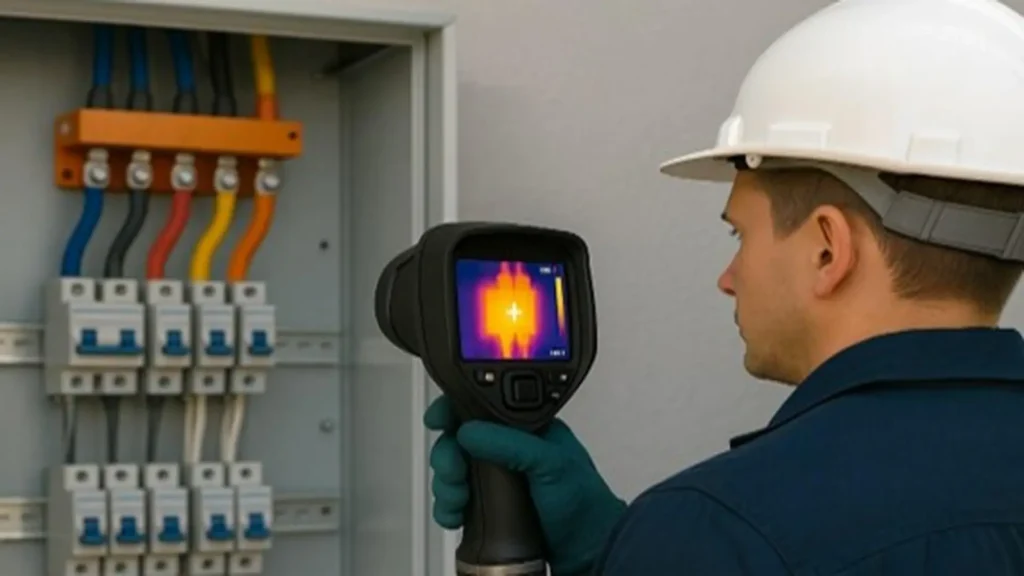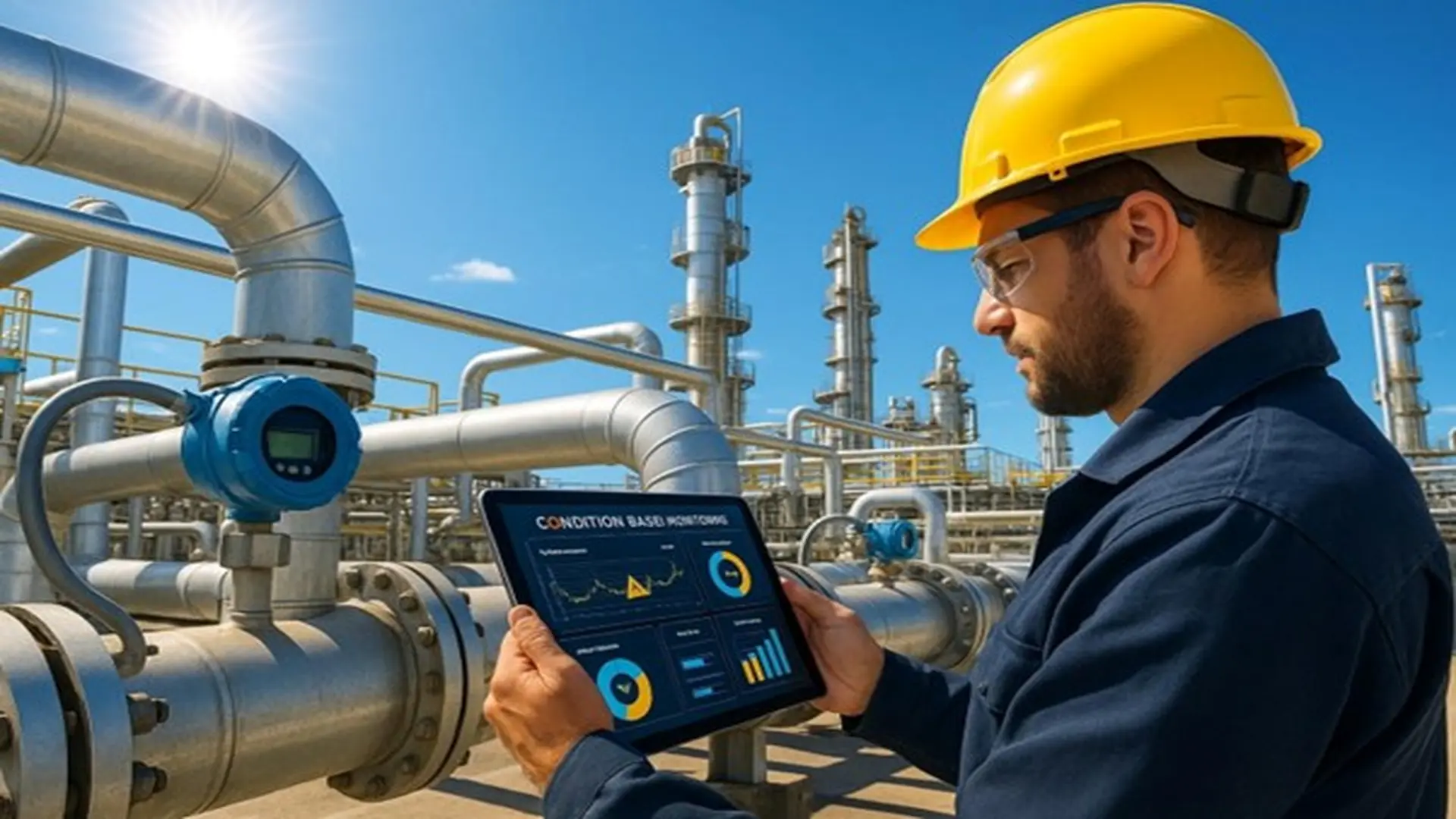Table of Contents
- Why is condition-based monitoring critical?
- What is Condition-Based Monitoring (CBM)?
- Principles of Condition Based Asset supervision
- Technologies in Condition Based Monitoring
- Benefits of CBM in operational reliability
- Success story: Penspen and CBM in critical assets
- Expert Perspective: Penspen in the CBM era
- CBM and its relationship with modern integrity management
- The future of monitoring: Intelligent maintenance
- Conclusions
- References
- FAQs
Condition-Based Monitoring (CBM) has become an essential pillar to ensure industrial reliability and strengthen Asset Integrity Management in the energy sector. In an environment where equipment operates under high demand, thermal variations, dynamic loads, and continuous cycles, anticipating a failure represents the difference between operational continuity and an expensive shutdown.
Today, thanks to IoT sensors, advanced analytics, and digital platforms, it is possible to monitor assets in real time, identify abnormal behavior, and make well-founded decisions. Under this vision, CBM drives the evolution toward intelligent maintenance.
Why is condition-based monitoring critical?
The energy and industrial sectors operate under highly demanding conditions. A stopped compressor, a pump failure, or a leak in a pipeline can generate million-dollar losses, operational risks, and significant environmental impacts.
For this reason, operational reliability has been established as a strategic, non-negotiable pillar. In this high-risk ecosystem, assets constantly face complex damage mechanisms:
- Mechanical fatigue: Generated by cycles of tension and relaxation.
- Accelerated corrosion: Internal or external, linked to transported fluids or the environment.
- Abnormal vibrations: Indicators of misalignment or imbalance in rotating equipment.
- Thermal overloads and electrical failures: Compromising insulation and components.
- Unplanned process variations, generating million-dollar losses.
International standards such as ISO 55000 (Asset Management) and API 580/581 (Risk-Based Inspection) emphasize that real-time information and data must be the fundamental driver of maintenance and integrity. This is where condition-based monitoring provides the decisive difference: it turns simple data into high-impact predictive decisions.
What is Condition-Based Monitoring (CBM)?
Condition-based operational monitoring (CBM) is a predictive maintenance strategy that uses the actual condition of an asset to decide when to intervene, avoiding calendar-based interventions.
Elements of the CBM process
- Sensorization and data acquisition: Use of specialized sensors that capture degradation signals (vibration, temperature, ultrasound, pressure, corrosion).
- Advanced analytics: Algorithms (often AI-based) that interpret asset behavior and transform data into readable information.
- Alarm management: Definition of thresholds and alarms established under engineering standards (example: ISO 10816 for vibrations) to alert on critical deviations.
- Prediction and diagnostics: Modeling the deterioration curve to estimate Remaining Useful Life (RUL).
- Informed decisions: Generation of precise work orders to avoid unplanned downtime.
CBM naturally integrates into the Industry 4.0 concept, where systems are not only connected but intelligent, capable of autonomously improving predictive models.
Principles of Condition Based Asset supervision
The effectiveness of CBM is based on physics and engineering principles that allow early-stage failure diagnostics.
- Precursor signal principle: Every defective component generates degradation signals. Abnormal vibrations, unusual thermal changes, ultrasonic noise, or electrical variations typically precede and warn of failure.
- Observable trend principle (P-F curve): Deterioration never occurs suddenly without leaving trace. Degradation is a process that can be recorded, measured, and crucially, modeled over time.
- Measurement anticipation principle: The window of opportunity for anticipation is directly proportional to the quality, frequency, and fidelity of the data. Measuring rigorously means anticipating intervention.
- Added value principle: Strategic value does not lie in the sensor itself, but in predictive analysis and diagnostics that turn raw data into engineering decisions.
- Opportunity principle: Operational reliability is guaranteed by timely information. The cost of a single unforeseen failure far exceeds the investment in years of a condition-based monitoring system.
Technologies in Condition Based Monitoring
Continuous evaluation of asset condition is a multi-technology system using different tools to assess equipment and pipelines from various perspectives, increasing predictive diagnostic precision.
Vibration analysis
Vibration analysis is the most widely used technique for compressors, pumps, turbines, and rotating equipment. It detects:
- Imbalance
- Misalignment
- Looseness
- Deteriorated bearings
- Gear problems
The spectral image of vibration frequency analysis shows the root cause:
Example: A vibration with frequency equal to rotational speed (1X) usually indicates imbalance, while multiple frequencies (2X, 3X) indicate misalignment.
Infrared thermography
Through infrared thermography, it is possible to visualize thermal anomalies:
- Electrical hot spots
- Excessive friction
- Flow blockage
- Thermal insulation failures
- Connection and starter issues
Example: A hot spot in an electrical panel indicates a loose connection or overload; in a bearing, it signals excessive friction or lubrication failure.

This method is ideal for rapid inspections and comparative analysis.
IoT sensors and Industrial Telemetry (Digital Monitoring)
IoT technology enables remote, real-time monitoring of thousands of variables: global vibration, pipeline corrosion, pressure, temperature, and acoustic leaks. Wireless networks, easy to install, cover large process units without costly traditional wiring.
Advanced ultrasound for CBM
Through ultrasound application, it is possible to detect:
- Steam and compressed air leaks
- Internal friction
- Lubrication issues
- Electrical arcing
- Mechanical deterioration
Its sensitivity makes it ideal for intelligent maintenance.
Example: It precisely detects compressed air or steam leaks (identified by high-frequency sound) or early-stage internal friction in a bearing, often before low-frequency vibration reveals it.
CBM applied to pipelines (Integrity Management)
In pipelines and process lines, the following are used:
- EMAT
- Corrosion probes
- Hydrogen sensors
- In-line corrosion wall loss measurement
- Acoustic emission for leak or active crack detection
In static pipelines and lines, CBM focuses on corrosion and cracking:
Techniques: Corrosion probes, in-line thickness loss measurement, and Acoustic Emission, which listens for microscopic “clicks” generated by crack growth or active corrosion in real time.
Systems integration (Digital monitoring + CMMS + EAM)
CBM information must turn into action. Computerized Maintenance Management Systems (CMMS) and Enterprise Asset Management (EAM) platforms integrate with online digital monitoring to generate:
- Automatic work orders based on risk thresholds
- Trend analysis to prioritize interventions
- Intelligent reports
- Connectivity with predictive models to refine RUL estimation
Benefits of CBM in operational reliability
The implementation of predictive asset condition control prevents failures and redefines operational economics.
| Key benefit | Quantifiable impact | Explanation |
|---|---|---|
| Reduction of unexpected Failures | 30–50% decrease | Predictive intervention eliminates catastrophic failures |
| Life extension | Maximizes component operation | Avoids replacing healthy parts, using the asset through its safe window |
| Increased safety | Reduces operational risks | Early detection of leaks and overheating protects personnel and environment |
| Better planning | Shorter, more precise interventions | Planned shutdowns, spare parts ready (Just in Time), reduced logistics and labor costs |
| Pipeline integrity | Continuous risk monitoring | CBM techniques (acoustic emission, corrosion probes) strengthen pipeline integrity |
Industries that implement CBM experience immediate reliability improvement.
Comparative Table: CBM vs Preventive vs Predictive
| Strategy | How it works | Advantages | Limitations |
|---|---|---|---|
| Preventive | Calendar-based intervention | Simple, standard | May intervene too early or too late |
| Predictive | Trend modeling | High precision | Requires historical data |
| CBM | Measures actual condition | Exact interventions, fewer failures | Requires sensors and continuous analysis |
CBM is the strategy most aligned with operational reliability and Industry 4.0.
Success story: Penspen and CBM in critical assets
Penspen, as Inspenet’s strategic partner and an international reference in engineering and pipeline integrity, has demonstrated the transformative value of Condition-Based Monitoring applied to critical infrastructure. Penspen’s international experience provides a clear example of the value offered by intelligent inspection as part of condition-based monitoring.
One of the most representative cases occurred in a 57 km, 42-inch oil pipeline in Indonesia, where the operator faced uncertainty about the real condition of the pipeline just months after commissioning.
To evaluate its condition, Penspen applied an advanced Smart Pig Fingerprint internal inspection, capable of capturing thousands of metal-loss signals with much higher resolution than traditional techniques. The result revealed a critical finding:
more than 41,462 internal indications compatible with early corrosion, distributed along several pipeline sections.
Given this evidence, the integrity team determined that 10 segments did not meet ASME B31.G requirements, and were immediately replaced to ensure safe operation.
A subsequent investigation identified the root cause:
corrosion did not originate in service, but during pipe transport and storage before pipeline construction.
This case demonstrated two key elements:
- Intelligent inspection provides a level of detail impossible to obtain with conventional methods.
- Condition data enables early and precise decisions, avoiding major failures and future contractual conflicts.
In practical terms, Penspen transformed complex data into a clear integrity strategy, reinforcing operational safety and validating that the system, once intervened, was fit for operation according to its original design.
Case conclusion: This real scenario shows how Condition-Based Monitoring is essential to identify hidden risks, validate failure hypotheses, and strengthen Integrity Management in critical pipelines.
Expert Perspective: Penspen in the CBM era
During the AMPP 2025 conference in Nashville, Peter O’Sullivan, CEO of Penspen, shared the strategic vision and evolution of the company at a crucial moment for the energy sector. With more than 70 years of experience, Penspen reaffirms its commitment to safer and more sustainable energy infrastructure aligned with the challenges of the energy transition.
In an exclusive interview for Inspenet TV, O’Sullivan highlighted how digitalization, predictive models, and advanced data management are redefining asset integrity. He emphasized that Penspen’s solutions—especially its digital platforms such as THEIA—are based on key principles of Condition-Based Monitoring: continuous monitoring, intelligent analysis, and evidence-based decision-making.
His vision confirms that the future of industrial reliability depends on integrated ecosystems where CBM, IoT, and advanced engineering work together to anticipate failures and optimize the operation of critical assets.
Penspen: leader in energy transition through digitalization, THEIA, and innovation

CBM and its relationship with modern integrity management
Predictive equipment diagnostics is a key part of the industrial integrity ecosystem:
- RBI (Risk-Based Inspection)
- FFS (Fitness for Service)
- Asset integrity programs
- ISO 55000 – Asset Management
- API 580/581 – Failure probability risk
Data from CBM directly feeds:
- Risk matrices.
- Inspection plans.
- Remaining life analysis.
- Maintenance cost reduction.
CBM is the natural evolution of traditional predictive maintenance.
The future of monitoring: Intelligent maintenance

Implementation of intelligent maintenance within predictive condition control advances toward complete automation and artificial intelligence:
- Artificial Intelligence & Machine Learning: Advanced models that detect known failure patterns and learn new asset-specific patterns.
- Edge Computing: Data processing at or near the sensor for instant decisions without cloud latency.
- Digital Twins: Virtual replicas of equipment and pipelines that simulate deterioration and evaluate maintenance scenarios.
- Prescriptive Maintenance: The most advanced stage—systems not only predict failures but recommend the optimal corrective action automatically.
Maintenance evolves from reactive and predictive to prescriptive, automatic, and continuous, with CBM as the catalyst for this transformation.
Conclusions
Condition-based monitoring has become the most powerful tool to ensure reliability, integrity, and sustainability of industrial assets. Its ability to transform operational data into predictive decisions enables failure anticipation, resource optimization, and business continuity protection.
Technological partners like Penspen demonstrate that CBM is not a trend—it is the foundation of intelligent maintenance and the central component of IoT, advanced analytics, and Industry 4.0 integration.
In the transition toward safer and more efficient operations, CBM represents the strongest path to achieving reliable, connected, and future-ready asset integrity.
“Elevate your asset reliability. Inspenet connects you with the best CBM strategies and leading experts.”
This article is part of Inspenet’s editorial line as the official media partner of global events such as GASTECH, API, AMPP, SLOM, and others.
References
- Linton, Leon; “Condition-Based Monitoring and Maintenance: State of the Art Review”, Applied Sciences, Vol. 12, No. 2 (2022).
- Yodoa, Nita; Afrina, Tanzina; Yadava, Om P.; et al., “Condition-based monitoring as a robust strategy towards sustainable and resilient multi-energy infrastructure systems”, International Journal of Distributed Energy Resources, Vol. S1, pp. 170-189 (2022).
- Zhang, Li; “Operation Condition Monitoring for Pipeline”, Chapter in Advanced Intelligent Pipeline Management Technology, Springer Link (2023).
- ISO 55000 Standard — Asset management — Overview, principles and terminology (ISO 55000:2014)
- API 580 / API 581 – Risk-Based Inspection, API Recommended Practice 580 – 3rd Edition (2016)
FAQs
What is a condition-based monitoring system?
A system that evaluates the actual condition of an asset to decide when to intervene, using sensors, analysis, and predictive models.
What benefits does CBM offer?
Reduces failures, decreases downtime, increases reliability, and optimizes maintenance costs.
What technologies are used in CBM?
Vibration, thermography, ultrasound, IoT sensors, digital monitoring, CMMS, acoustic emission, predictive analytics.

